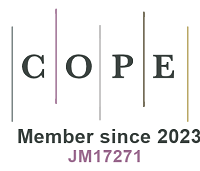REFERENCES
1. Schwarzenbach RP, Escher BI, Fenner K, et al. The challenge of micropollutants in aquatic systems. Science 2006;313:1072-7.
2. Dachs J, Méjanelle L. Organic pollutants in coastal waters, sediments, and biota: a relevant driver for ecosystems during the anthropocene? Estuaries Coasts 2010;33:1-14.
3. ATSDR. Per- and polyfluoroalkyl substances (PFAS) and your health. 2023. Available from: https://www.atsdr.cdc.gov/pfas/health-effects/index.html. [Last accessed on 16 May 2023].
4. Cousins IT, Johansson JH, Salter ME, Sha B, Scheringer M. Outside the safe operating space of a new planetary boundary for per- and polyfluoroalkyl substances (PFAS). Environ Sci Technol 2022;56:11172-9.
5. Eisenreich SJ, Capel PD, Robbins JA, Bourbonniere R. Accumulation and diagenesis of chlorinated hydrocarbons in lacustrine sediments. Environ Sci Technol 1989;23:1116-26.
6. Stockhom convention of persistent organic pollutants 2011. UNEP/POPS/COP.5/INF/27. Available from: http://www.pops.int/TheConvention/ThePOPs/AllPOPs/tabid/2509/Default.aspx. [Last accessed on 16 May 2023].
7. Ankley GT, Coady KK, Gross M, et al. A critical review of the environmental occurrence and potential effects in aquatic vertebrates of the potent androgen receptor agonist 17β-trenbolone. Environ Toxicol Chem 2018;37:2064-78.
8. Masset T, Cottin N, Piot C, Fanget P, Naffrechoux E. PCB mass budget in a perialpine lake undergoing natural decontamination in a context of global change. Sci Total Environ 2019;693:133590.
9. Mudgal S, De Toni A, Lockwood S, Sales K, Backhaus T, Sorenson BH. Study on the environmental risks of medicinal products. Final report, 308 p. Available from: https://health.ec.europa.eu/system/files/2016-11/study_environment_0.pdf. [Last accessed on 16 May 2023].
10. Ankley GT, Brooks BW, Huggett DB, Sumpter JP. Repeating history: pharmaceuticals in the environment. Environ Sci Technol 2007;41:8211-7.
11. Jobling S, Burn RW, Thorpe K, Williams R, Tyler C. Statistical modeling suggests that antiandrogens in effluents from wastewater treatment works contribute to widespread sexual disruption in fish living in English rivers. Environ Health Perspect 2009;117:797-802.
12. Novak PJ, Arnold WA, Blazer VS, et al. On the need for a National (U.S.) research program to elucidate the potential risks to human health and the environment posed by contaminants of emerging concern. Environ Sci Technol 2011;45:3829-30.
13. Richardson SD, Ternes TA. Water analysis: emerging contaminants and current issues. Anal Chem 2014;86:2813-48.
14. Patel N, Khan MDZ, Shahane S, et al. Emerging pollutants in aquatic environment: source, effect, and challenges in biomonitoring and bioremediation - a review. Pollution :2020 6, 99 - 113.
15. Loos R, Gawlik BM, Locoro G, Rimaviciute E, Contini S, Bidoglio G. EU-wide survey of polar organic persistent pollutants in European river waters. Environ Pollut 2009;157:561-8.
16. Silva BF, Jelic A, López-Serna R, Mozeto AA, Petrovic M, Barceló D. Occurrence and distribution of pharmaceuticals in surface water, suspended solids and sediments of the Ebro river basin, Spain. Chemosphere 2011;85:1331-9.
17. Hartmann J, van Driezum I, Ohana D, et al. The effective design of sampling campaigns for emerging chemical and microbial contaminants in drinking water and its resources based on literature mining. Sci Total Environ 2020;742:140546.
19. Tang JY, McCarty S, Glenn E, Neale PA, Warne MS, Escher BI. Mixture effects of organic micropollutants present in water: towards the development of effect-based water quality trigger values for baseline toxicity. Water Res 2013;47:3300-14.
20. Kunz PY, Kienle C, Carere M, Homazava N, Kase R.
21. Kunz PY, Simon E, Creusot N, et al. Effect-based tools for monitoring estrogenic mixtures: Evaluation of five
22. Loos R, Carvalho R, António DC, et al. EU-wide monitoring survey on emerging polar organic contaminants in wastewater treatment plant effluents. Water Res 2013;47:6475-87.
23. Sumpter JP, Jobling S. The occurrence, causes, and consequences of estrogens in the aquatic environment. Environ Toxicol Chem 2013;32:249-51.
24. Sumpter JP, Johnson AC, Williams RJ, Kortenkamp A, Scholze M. Modeling effects of mixtures of endocrine disrupting chemicals at the river catchment scale. Environ Sci Technol 2006;40:5478-89.
25. Jarošová B, Erseková A, Hilscherová K, et al. Europe-wide survey of estrogenicity in wastewater treatment plant effluents: the need for the effect-based monitoring. Environ Sci Pollut Res Int 2014;21:10970-82.
26. Petrie B, Barden R, Kasprzyk-Hordern B. A review on emerging contaminants in wastewaters and the environment: current knowledge, understudied areas and recommendations for future monitoring. Water Res 2015;72:3-27.
27. Kase R, Javurkova B, Simon E, et al. Screening and risk management solutions for steroidal estrogens in surface and wastewater. TrAC Trends Anal Chem 2018;102:343-58.
28. Könemann S, Kase R, Simon E, et al. Effect-based and chemical analytical methods to monitor estrogens under the European Water Framework Directive. TrAC Trends Anal Chem 2018;102:225-35.
29. Sonavane M, Schollée JE, Hidasi AO, et al. An integrative approach combining passive sampling, bioassays, and effect-directed analysis to assess the impact of wastewater effluent. Environ Toxicol Chem 2018;37:2079-88.
30. Kortenkamp A. Low dose mixture effects of endocrine disrupters: implications for risk assessment and epidemiology. Int J Androl 2008;31:233-40.
31. Carvalho RN, Ceriani L, Ippolito A, Lettieri T. Development of the first watch list under the environmental quality standards directive (Science and policy reports No. EUR 27142 EN). Available from: https://publications.jrc.ec.europa.eu/repository/handle/JRC95018. [Last accessed on 16 May 2023].
32. Liney KE, Hagger JA, Tyler CR, Depledge MH, Galloway TS, Jobling S. Health effects in fish of long-term exposure to effluents from wastewater treatment works. Environ Health Perspect 2006;114 Suppl 1:81-9.
33. Caldwell DJ, Mastrocco F, Anderson PD, Länge R, Sumpter JP. Predicted-no-effect concentrations for the steroid estrogens estrone, 17β-estradiol, estriol, and 17α-ethinylestradiol. Environ Toxicol Chem 2012;31:1396-406.
34. Brown AC, Stevenson LM, Leonard HM, Nieves-Puigdoller K, Clotfelter ED. Phytoestrogens β -sitosterol and genistein have limited effects on reproductive endpoints in a female fish, Betta splendens. Biomed Res Int 2014;2014:681396.
35. Bhandari RK, Wang X, Saal FSV, Tillitt DE. Transcriptome analysis of testis reveals the effects of developmental exposure to bisphenol a or 17α-ethinylestradiol in medaka (Oryzias latipes). Aquat Toxicol 2020;225:105553.
36. Anderson PD, Johnson AC, Pfeiffer D, et al. Endocrine disruption due to estrogens derived from humans predicted to be low in the majority of U.S. surface waters. Environ Toxicol Chem 2012;31:1407-15.
37. Tang Z, Liu ZH, Wang H, et al. Trace determination of eleven natural estrogens and insights from their occurrence in a municipal wastewater treatment plant and river water. Water Res 2020;182:115976.
38. Vandermarken T, Croes K, Van Langenhove K, et al. Endocrine activity in an urban river system and the biodegradation of estrogen-like endocrine disrupting chemicals through a bio-analytical approach using DRE- and ERE-CALUX bioassays. Chemosphere 2018;201:540-9.
39. Johnson AC, Dumont E, Williams RJ, Oldenkamp R, Cisowska I, Sumpter JP. Do concentrations of ethinylestradiol, estradiol, and diclofenac in European rivers exceed proposed EU environmental quality standards? Environ Sci Technol 2013;47:12297-304.
40. Connon RE, Geist J, Werner I. Effect-based tools for monitoring and predicting the ecotoxicological effects of chemicals in the aquatic environment. Sensors 2012;12:12741-71.
41. Escher BI, van Daele C, Dutt M, Tang JY, Altenburger R. Most oxidative stress response in water samples comes from unknown chemicals: the need for effect-based water quality trigger values. Environ Sci Technol 2013;47:7002-11.
42. Altenburger R, Ait-Aissa S, Antczak P, et al. Future water quality monitoring-adapting tools to deal with mixtures of pollutants in water resource management. Sci Total Environ 2015;512-513:540-51.
43. Wernersson A, Carere M, Maggi C, et al. The European technical report on aquatic effect-based monitoring tools under the water framework directive. Environ Sci Eur 2015:27.
44. European Commission, Fitness check of the water framework directive and floods directive. 2019. Available from: http://eeac.eu/wp-content/uploads/2020/01/2020-01-13_Council_Fitness-Check-Water_HS.pdf. [Last accessed on 22 May 2023].
45. European Commission, Technical report on aquatic effect-based monitoring tools. 2017. Available from: https://circabc.europa.eu/sd/a/0d78bbf7-76f0-43c1-8af2-6230436d759d/Effectbased%20tools%20CMEP%20report%20main%2028%20April%202014.pdf. [Last accessed on 16 May 2023].
46. Campbell CG, Borglin SE, Green FB, Grayson A, Wozei E, Stringfellow WT. Biologically directed environmental monitoring, fate, and transport of estrogenic endocrine disrupting compounds in water: A review. Chemosphere 2006;65:1265-80.
47. Guo W, Van Langenhove K, Vandermarken T, et al. In situ measurement of estrogenic activity in various aquatic systems using organic diffusive gradients in thin-film coupled with ERE-CALUX bioassay. Environ Int 2019;127:13-20.
48. Brion N, Verbanck MA, Bauwens W, Elskens M, Chen M, Servais P. Assessing the impacts of wastewater treatment implementation on the water quality of a small urban river over the past 40 years. Environ Sci Pollut Res Int 2015;22:12720-36.
49. Pfannkuche J, Schmidt A. Determination of suspended particulate matter concentration from turbidity measurements: particle size effects and calibration procedures. Hydrol Process 2003;17:1951-63.
50. Rogers JM, Denison MS. Recombinant cell bioassays for endocrine disruptors: development of a stably transfected human ovarian cell line for the detection of estrogenic and anti-estrogenic chemicals. In vitr Mol Toxicol ;2000 13:67-82.
51. Brennan JC, Bassal A, He G, Denison MS. Development of a recombinant human ovarian (BG1) cell line containing estrogen receptor α and β for improved detection of estrogenic/antiestrogenic chemicals. Environ Toxicol Chem 2016;35:91-100.
52. Elskens M, Baston DS, Stumpf C, et al. CALUX measurements: statistical inferences for the dose-response curve. Talanta 2011;85:1966-73.
53. Elwan A, Singh R, Patterson M, et al. Influence of sampling frequency and load calculation methods on quantification of annual river nutrient and suspended solids loads. Environ Monit Assess 2018;190:78.
54. Miège C, Choubert JM, Ribeiro L, Eusèbe M, Coquery M. Fate of pharmaceuticals and personal care products in wastewater treatment plants--conception of a database and first results. Environ Pollut 2009;157:1721-6.
55. Zhou Y, Zha J, Wang Z. Occurrence and fate of steroid estrogens in the largest wastewater treatment plant in Beijing, China. Environ Monit Assess 2012;184:6799-813.
56. Snyder SA, Westerhoff P, Yoon Y, Sedlak DL. Pharmaceuticals, personal care products, and endocrine disruptors in water: implications for the water industry. Environ Eng Sci 2003;20:449-69.
57. Liu YF, Lu G, Yin H, Dang Z, Rittmann B. Removal of natural estrogens and their conjugates in municipal wastewater treatment plants: A critical review. Environ Sci Tech :2015 49, 5288-5300.
58. Ting YF, Praveena SM. Sources, mechanisms, and fate of steroid estrogens in wastewater treatment plants: a mini review. Environ Monit Assess 2017;189:178.
59. Díaz-cruz M, García-galán M, Guerra P, et al. Analysis of selected emerging contaminants in sewage sludge. TrAC Trends Anal Chem 2009;28:1263-75.
60. Nieto A, Borrull F, Pocurull E, Marcé RM. Occurrence of pharmaceuticals and hormones in sewage sludge. Environ Toxicol Chem 2010;29:1484-9.
61. Avberšek M, Žegura B, Filipič M, Heath E. Integration of GC-MSD and ER-Calux® assay into a single protocol for determining steroid estrogens in environmental samples. Sci Total Environ 2011;409:5069-75.
62. Altenburger R, Brack W, Burgess RM, et al. Future water quality monitoring: improving the balance between exposure and toxicity assessments of real-world pollutant mixtures. Environ Sci Eur 2019:31.
63. Simon E, Duffek A, Stahl C, et al. Biological effect and chemical monitoring of Watch List substances in European surface waters: Steroidal estrogens and diclofenac- Effect-based methods for monitoring frameworks. Environ Int 2022;159:107033.
64. Vajda AM, Barber LB, Gray JL, Lopez EM, Woodling JD, Norris DO. Reproductive disruption in fish downstream from an estrogenic wastewater effluent. Environ Sci Technol 2008;42:3407-14.
65. Barber LB, Rapp JL, Kandel C, et al. Integrated assessment of wastewater reuse, exposure risk, and fish endocrine disruption in the shenandoah river watershed. Environ Sci Technol 2019;53:3429-40.
66. Harraka GT, Magnuson JT, Du B, Wong CS, Maruya K, Schlenk D. Evaluating the estrogenicity of an effluent-dominated river in California, USA: Comparisons of







